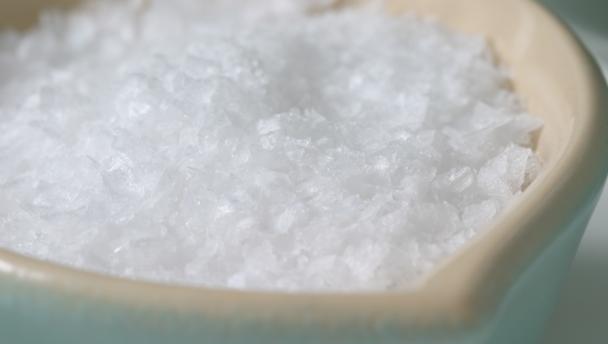

Salt is a mineral essential to the human body, yet we tend to think of it as a spice essential to cooking. It sharpens flavour and stimulates the tastebuds, helping make other food tastier and more appetising, and is an important preservative. In countries where salt is not added directly to food, other ingredients (such as soy sauce and other fermented pastes and liquids) add a salty component.
 Southern-style pork and beans
Southern-style pork and beans
 How to make steak and ale pie
How to make steak and ale pie
 Dry curry of cabbage, carrot and coconut (Thoran)
Dry curry of cabbage, carrot and coconut (Thoran)
 Bolognese sausage ragù with tagliatelle
Bolognese sausage ragù with tagliatelle
 Summer salad
Summer salad
 Spiced chickpea, red pepper, aubergine and quinoa grain bowl
Spiced chickpea, red pepper, aubergine and quinoa grain bowl
 Mexican sweetcorn pancakes, poached eggs and salsa
Mexican sweetcorn pancakes, poached eggs and salsa
 Tomato rubbed toast
Tomato rubbed toast
 Fluffy American pancakes
Fluffy American pancakes
 Canadian buttermilk pancakes with maple syrup
Canadian buttermilk pancakes with maple syrup
 Avocado hummus
Avocado hummus
 Potato and chickpea dhansak with mini puri
Potato and chickpea dhansak with mini puri
 Yorkshire puddings
Yorkshire puddings
 Roast sweet potato chilli chips
Roast sweet potato chilli chips
 Chickpea and tomato salad with tahini dressing
Chickpea and tomato salad with tahini dressing
 Ginger-glazed carrots
Ginger-glazed carrots
 Sautéed caramelised fennel
Sautéed caramelised fennel
 Rhubarb crumble and cream
Rhubarb crumble and cream
 Proper apple pie
Proper apple pie
 Basic pancakes with sugar and lemon
Basic pancakes with sugar and lemon
 Cappuccino profiteroles
Cappuccino profiteroles
 Raspberry, peach and almond tart
Raspberry, peach and almond tart
 Cookies and cream fudge brownies
Cookies and cream fudge brownies
 Paul Hollywood’s bloomer
Paul Hollywood’s bloomer
 German apple cake
German apple cake
 Focaccia
Focaccia
 Spiced hot coconut drink
Spiced hot coconut drink
 The ultimate masala tea
The ultimate masala tea
 Chocolate avocado shake
Chocolate avocado shake
 Bread sauce
Bread sauce
 Cranberry and Cumberland sauce
Cranberry and Cumberland sauce
 Veggie gravy
Veggie gravy
Salt is available as sea salt or rock salt. Sea salt is more highly prized than rock salt, which is mined and must be further refined to make cooking salt and table salt.
Saltiness is masked by sweetness and enhanced by bitterness and sourness. Adding a squeeze of lemon juice to a dish can make it taste saltier without the need to add more salt.
Overconsumption of salt is thought to be linked to high blood pressure, heart disease and strokes, although some critics dispute this. Six grams of salt is a level teaspoonful, but measuring consumption of salt is not as simple as that because 65-85 per cent of the salt we eat is 'hidden' in ready-prepared foods, not added to home-cooked dishes while cooking or at the table. Bread, breakfast cereals, biscuits, baked beans and ready-meals can be high in salt, alongside more obviously salty-tasting foods such as crisps, bacon, cheese and olives. In 2006 the Food Standards Agency published voluntary salt reduction targets for food manufacturers and retailers to reduce salt levels by 2010.
Type the ingredients you want to use, then click Go. For better results you can use quotation marks around phrases (e.g. "chicken breast"). Alternatively you can search by chef, programme, cuisine, diet, or dish (e.g. Lasagne).